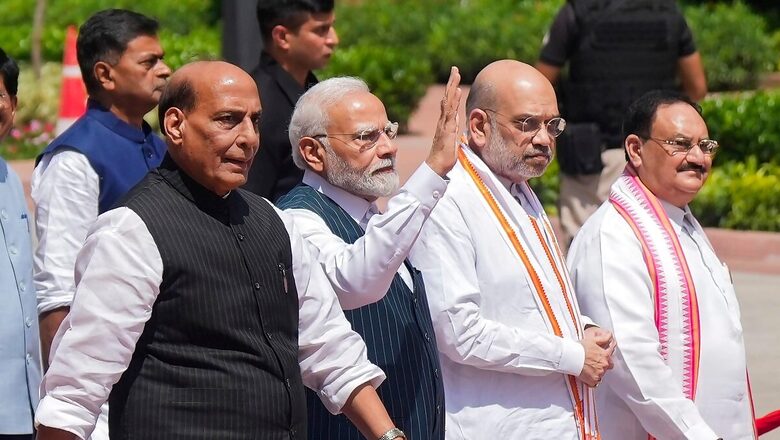
views
If the Lok Sabha results were interpreted by some as the beginning of the decline of Narendra Modi’s BJP, the Haryana and J&K assembly election results show that such exultation was premature. The BJP’s record third consecutive win in Haryana and its emergence as the largest national party in Jammu and Kashmir has significant implications for politics.
Here are five reasons why and how this changes the national polity
One, Haryana shows why BJP is not a pushover in Hindi heartland: The BJP fell short of a majority on its own in the Lok Sabha poll primarily because of reverses in its Hindi heartland bastions – UP, where it dipped badly; Haryana, where it lost half its parliamentary seats and Rajasthan, where it dropped a handful as well. These electoral setbacks were primarily driven by some OBC and Dalit voters, who had powered its previous electoral victories, again moving away from the party.
The BJP’s return to power for a record third consecutive term in Haryana now – just three months after those reverses – reflects how many of the drivers of the parliamentary reverses may have been more localised and temporary rather than signifying a major structural shift.
Taken together, this means that the BJP in the past three months managed to repair its social coalition in Haryana, which was largely based on non-Jat OBCs, Dalits and upper castes, while not losing significant Jat support. This shows the party’s capacity to recover lost ground in Hindi-speaking bastions and the relative durability of its social engineering, given the right conditions. The BJP’s 57.3 per cent strike rate in Haryana vs Congress’s 38.2 per cent reflects how in head-to-head contests, the saffron party continues to have an advantage.
Two, Brand Modi resurgent again. Congress needs to work on ground strength: It is important to keep in mind that Haryana is not a traditional BJP bastion, like say Gujarat or Madhya Pradesh. The BJP had never won power in the state till 2014. That was also the year when it crossed the 30 per cent vote threshold in the state for the first time. The BJP has no major pan-state leader in Haryana either, like Congress’s Bhupinder Singh Hooda. In fact, the party barely managed to retain power in 2019, when it allied with JJP, and recently took evasive action on anti-incumbency by removing Manoharlal Khattar as the CM.
In that sense, this victory reaffirms the enduring power of Brand Modi – the PM campaigned in as many as 27 rallies. It also reflects the advantages of the BJP’s strong cadre network in getting the vote out in close contests.
In contrast, the Congress suffered losses in most seats where Rahul Gandhi campaigned. Congress may have gained political momentum with a revival in national elections but Haryana highlights how much of a gap remains between both parties in electoral politics. This was Congress’s election to lose. And the result again raises questions about its ground game that it should address if it is to beat the BJP.
In Jammu and Kashmir, for example, the BJP has won its largest number of seats ever and its vote share (25.73 per cent) is over double than that of the Congress (12 per cent). In fact, the Congress got virtually wiped out in Jammu and failed to enter double digits in terms of seats overall in the region.
Three, Return of the RSS: By all accounts, the RSS cadres were out in strength again in this state election. After reports of a lacklustre and unmotivated cadre response in many northern states by the RSS and BJP cadres, the electoral jolt in June seems to have galvanised a deeper ground response. In both Jammu and Haryana, frenetic repair work by saffron cadres over the past month seems to have revived sagging political fortunes.
Four, BJP’s ability to retain states: BJP’s third straight triumph in Haryana reflects its ability to cement its expanding footprint once it reaches a critical mass in a new area. In the Hindi heartland, the Congress has not won back-to-back elections in any state over the past few years. Over the past decade, it beat the BJP in Rajasthan, Madhya Pradesh, Bihar and Chhattisgarh at various points, but did not succeed in retaining power in subsequent elections in any of these states. This is in sharp contrast to the BJP’s North India bounce-back record in all key states.
Five, Maharashtra is now a different election: These election results – which belie all exit polls – will significantly change the national political debate. By coming back from the dead in Haryana and turning what looked like a certain defeat into a confident victory, the BJP has managed to also change the temperature for the upcoming big battle in Maharashtra and Jharkhand. This will galvanise its cadre, restore faith in the leadership and put the Opposition parties on notice that this new BJP continues to be a formidable opponent that fights each battle to its last round.
Most importantly, politics is about momentum. Just three months ago, the Opposition looked like it had managed to slow down the BJP’s victory lap – if not stop it.
Narendra Modi’s BJP has turned the clock back again with the Haryana triumph and it sets the stage for more high-stakes battles ahead with Rahul Gandhi’s Congress.
Nalin Mehta is Managing Editor, Moneycontrol and Non-Resident Senior Fellow at Institute of South Asian Studies at the National University Singapore. He is the author of several best-selling and critically acclaimed books, including The New BJP and, most recently, India’s Techade. Views expressed in the above piece are personal and solely those of the author. They do not necessarily reflect News18’s views.


















Comments
0 comment